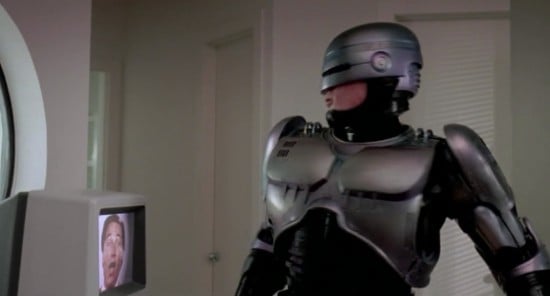Shocking Blocking (44)
By:
January 25, 2013

In an effort to explicate Jacques Lacan’s distinction between an all-too-human demand (in the act of making which you might gain insight into what you truly desire) and a monstrous, mechanical drive, Slavoj Žižek once pointed to the titular protagonist of RoboCop. Lacan’s own examples of fictional ex-humans embodying relentless drives — e.g., Antigone, who “died” when her brothers killed one another; or the ghost of Hamlet’s father — are highbrow ones. But Žižek, a good postmodernist, prefers lowbrow fare like Paul Verhoeven’s dystopian shoot-’em-up flick, in which, unlike most other unstoppable inhuman horror and sci-fi movie characters, the cyborg Murphy/Robocop (Peter Weller) undergoes “resubjectivation,” becoming gradually less monstrous. How best to convey the pathos and tragedy of what we might call the Ex-Ex-Human Condition? The violence-charged blocking in this cyborg vs. video-salesbot scene, set in a bedroom haunted not only by a vanished wife so truly desired that we can count the hairs on her all-too-human upper lip but by a relentlessly driven talking head, suggests that no matter how alluring it will surely become (and this was a quarter-century ago!), we must resist our own cyborg-ization.
An occasional series analyzing some of the author’s favorite moments in the positioning or movement of actors in a movie.
THIRTIES (1934–1943): It Happened One Night (1934) | The Man Who Knew Too Much (1934) | The Guv’nor (1935) | The 39 Steps (1935) | Young and Innocent (1937) | The Lady Vanishes (1938) | Mr. Smith Goes to Washington (1939) | The Big Sleep (1939) | The Little Princess (1939) | Gone With the Wind (1939) | His Girl Friday (1940)
FORTIES (1944–1953): The Diary of a Chambermaid (1946) | The Asphalt Jungle (1950) | The African Queen (1951)
FIFTIES (1954–1963): A Bucket of Blood (1959) | Beach Party (1963)
SIXTIES (1964–1973): For Those Who Think Young (1964) | Thunderball (1965) | Clambake (1967) | Bonnie and Clyde (1967) | Madigan (1968) | Wild in the Streets (1968) | Barbarella (1968) | Harold and Maude (1971) | The Mack (1973) | The Long Goodbye (1973)
SEVENTIES (1974–1983): Les Valseuses (1974) | Eraserhead (1976) | The Bad News Bears (1976) | Breaking Away (1979) | Rock’n’Roll High School (1979) | Escape from Alcatraz (1979) | Apocalypse Now (1979) | Caddyshack (1980) | Stripes (1981) | Blade Runner (1982) | Tender Mercies (1983) | Monty Python’s The Meaning of Life (1983)
EIGHTIES (1984–1993): Repo Man (1984) | Buckaroo Banzai (1984) | Raising Arizona (1987) | RoboCop (1987) | Goodfellas (1990) | Candyman (1992) | Dazed and Confused (1993) |
NINETIES (1994–2003): Pulp Fiction (1994) | The Fifth Element (1997)
OUGHTS (2004–13): Nacho Libre (2006) | District 9 (2009)
READ MORE essays by Joshua Glenn, originally published in: THE BAFFLER | BOSTON GLOBE IDEAS | BRAINIAC | CABINET | FEED | HERMENAUT | HILOBROW | HILOBROW: GENERATIONS | HILOBROW: RADIUM AGE SCIENCE FICTION | HILOBROW: SHOCKING BLOCKING | THE IDLER | IO9 | N+1 | NEW YORK TIMES BOOK REVIEW | SEMIONAUT | SLATE
Joshua Glenn’s books include UNBORED: THE ESSENTIAL FIELD GUIDE TO SERIOUS FUN (with Elizabeth Foy Larsen); and SIGNIFICANT OBJECTS: 100 EXTRAORDINARY STORIES ABOUT ORDINARY THINGS (with Rob Walker).
